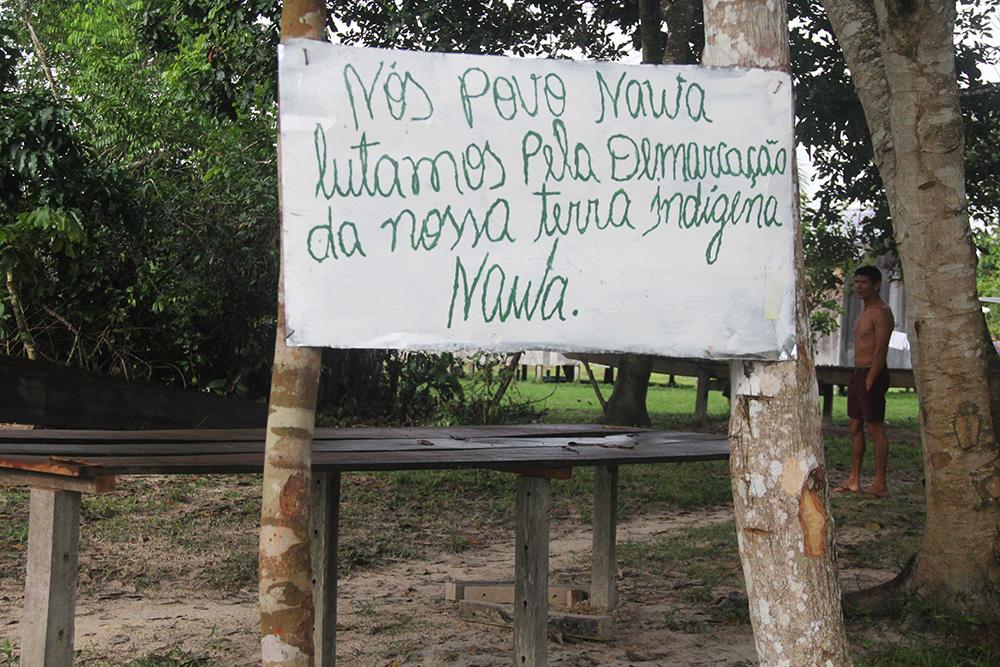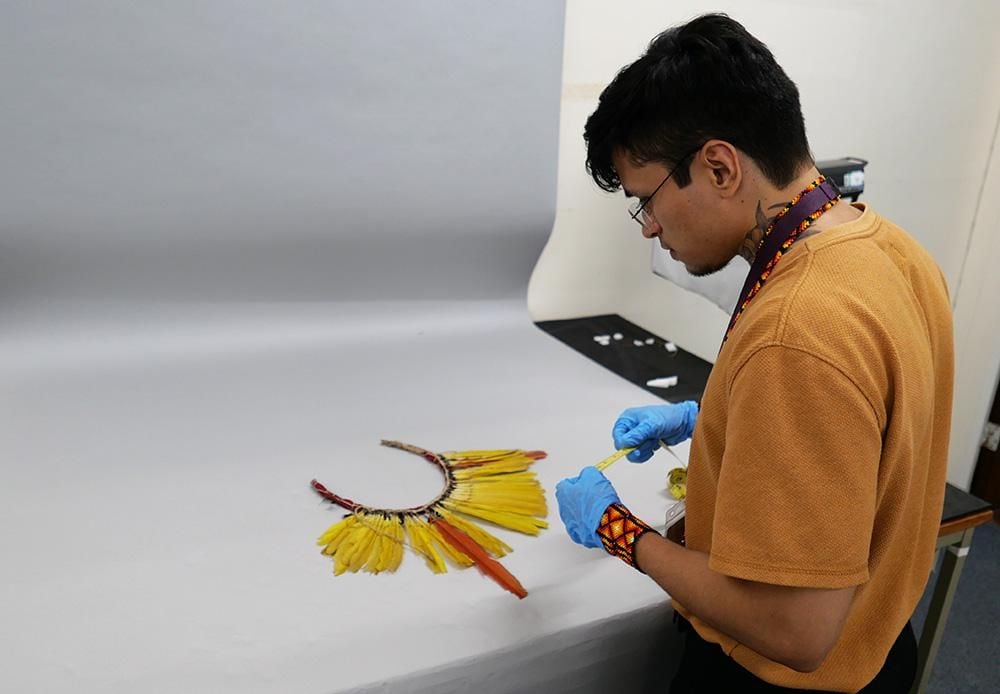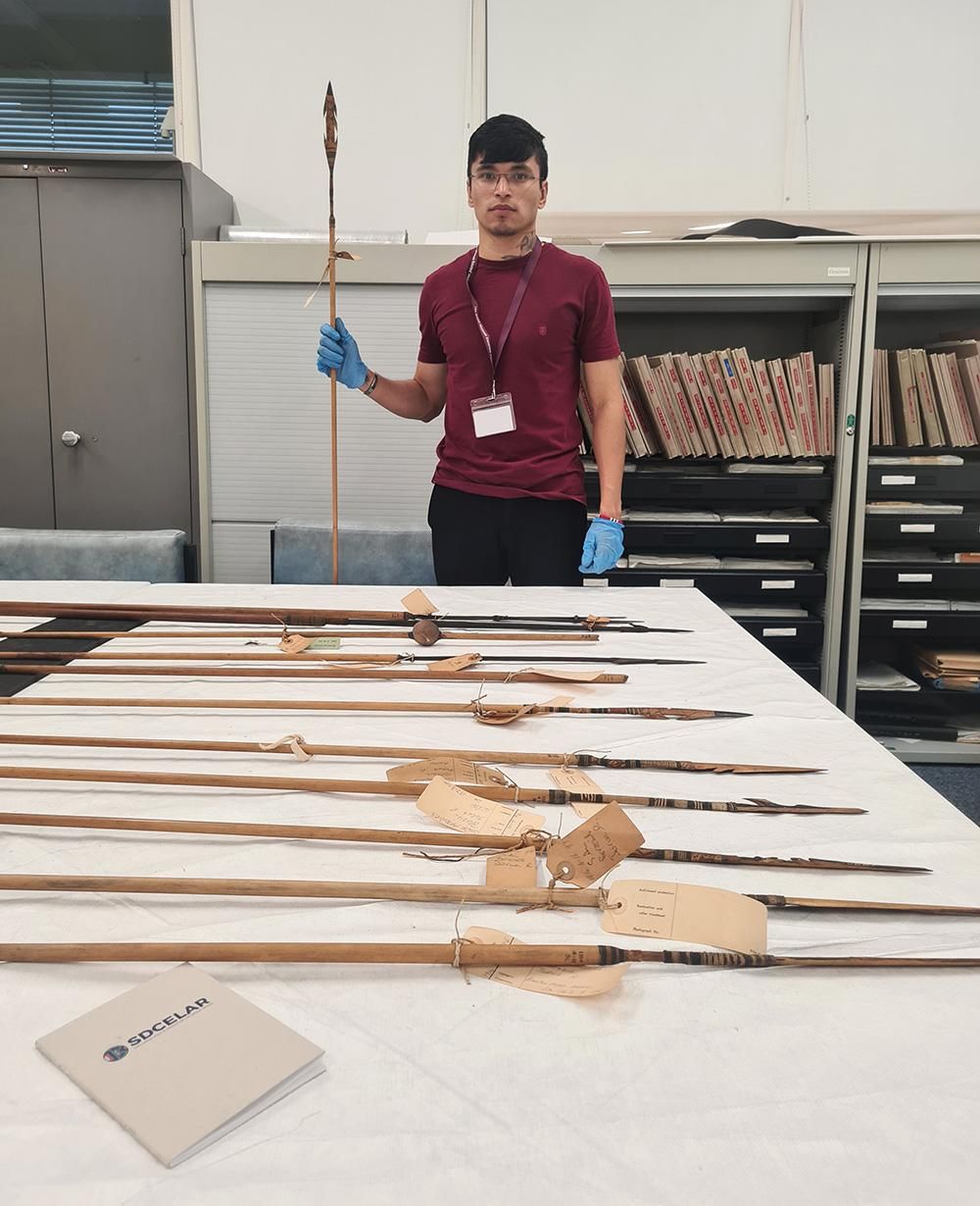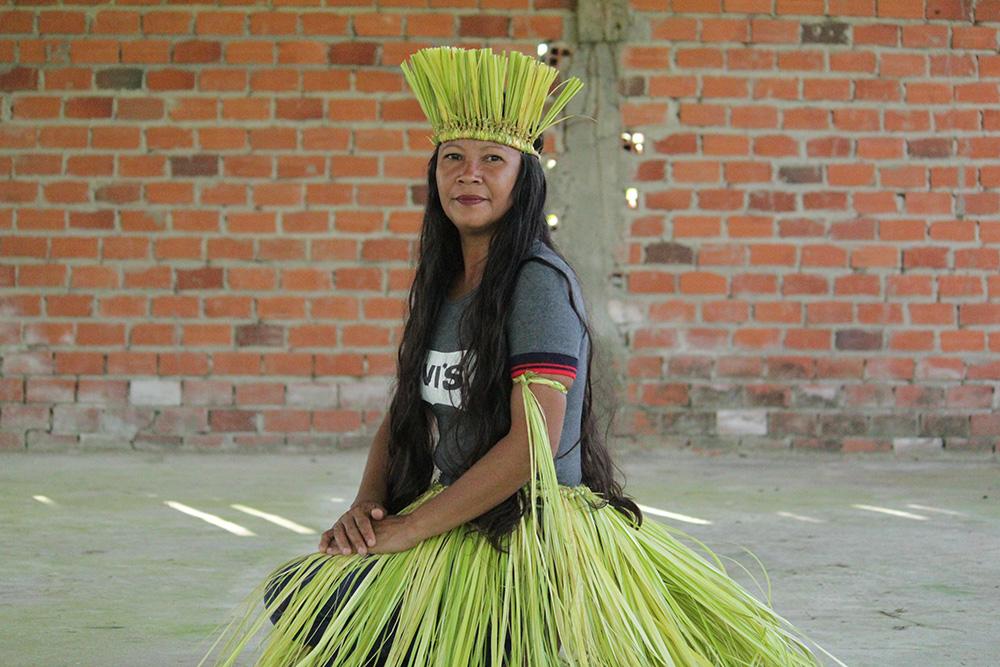Read the full interview in Portuguese on SDCELAR's website.
After a devastating fire at Brazil's National Museum almost entirely destroyed the country's largest collection of Indigenous objects, Indigenous curators such as Ykaruni Nawa have been rebuilding collections and retelling history from their own perspectives.
Ykaruni is from the Nawa people, who have been fighting for the official recognition and demarcation of their ancestral territory in Brazilian Amazonia for more than two decades. He is currently affiliated with the National Museum in Brazil where he has played a key role in the museum's revitalisation by helping to rebuild its ethnographic collections from native perspectives and storytelling.
Thanks to an ongoing collaboration between the Santo Domingo Centre for Latin American Research (SDCELAR) at the British Museum and the National Museum of Brazil, Ykaruni Nawa was invited to take part in the British Museum's International Training Programme (ITP) and to contribute to the documentation of objects from the Juruá River (Brazil) in the British Museum collection. The ITP is a skill-sharing programme for museum and heritage professionals from around the world, and in 2024 Ykaruni joined as the first Indigenous participant from Latin America. In this interview with the Head of SDCELAR, Louise de Mello, he discusses this collaborative work with SDCELAR and explains why it's so important.
About Ykaruni
Louise de Mello: Could you tell us a bit about yourself, your journey to the British Museum, and the co-curation work you've been developing with the National Museum in Brazil?
Ykaruni Nawa: The challenging journey that brought me to the British Museum is an Indigenous, ethnic and collective effort. I come from the Nawa people, who are from the Juruá River in Brazilian Amazonia, on the border between Brazil and Peru, and who now live in the Serra do Divisor National Park in the state of Acre. The Nawa are a group of people who, for over 100 years, had been thought to be extinct in Brazil as a result of extremely violent colonisation. Only two of my people survived and today I am the first member of the Nawa people to reach the highest level of 'white people's knowledge', a PhD. If I'm here today, it's by permission of my ancestors and my leaders. I faced many challenges in becoming the first, but I had a goal: to retell our story, which has always been told by white people, from our perspective.
To achieve this goal, I studied journalism and later anthropology, which is the field of my Master's and now my PhD, which I am doing at the National Museum in Brazil. As colonial narratives have never truly represented us, I arrived at the National Museum in Brazil determined to rewrite local history from our Indigenous perspective. Since the fire that struck the National Museum in 2018, the curatorial work I have been developing has not only national but also international impact, because my people were one of the key protagonists in the rubber boom that supplied international markets during the second industrial revolution at the beginning of the 20th century. I'm working directly with my community in a movement to document our oral narratives; the production processes of clay, fibre and vine materials; and to record the knowledge of the elders. This is so that this traditional knowledge is passed on to the next generation and is never lost again; so that the Nawa people is never again labelled as extinct; and so that our knowledge and identity continues to exist.
Challenges
Louise de Mello: What are the main challenges faced today by you individually as an Indigenous person, and collectively, for the Nawa people? How can this engagement with the Nawa collections at the British Museum contribute to overcoming some of these issues?
Ykaruni Nawa: Our main challenge today, both for me and my people, is the recognition of our territory. As our leaders in Brazil say, Mother Earth is the mother of all struggles, and without a doubt, what the Nawa people fights for the most is for the demarcation of our territory. Because of this, we, as Indigenous people, have undertaken our own 'self-demarcation'; that is to say that the demarcation of our territory must come from our own understanding of territory and sense of belonging to the territory where we live.
Today, self-demarcation is not just about physically and geographically demarcating land – and my big challenge has been to carry forward this perspective from our leaders. Self-demarcation is also about self-demarcating knowledge; self-demarcation means arriving at the British Museum and better documenting the objects of my people that are in storage; self-demarcation means identifying undocumented materials as my people's, recognising similar techniques, and thereby increasing the Juruá collection from 12 to 14 objects. It means learning a foreign language, mastering it, and rewriting history in this new language to reach other people around the world. It means making sure that not only I have access to the Museum, but that my work also reaches my community so that my leaders and my people are able to change the course of history as it is told here. It means mediating relations between the white world and the Indigenous world, in a way that guarantees the social wellbeing of a minority population that has made a fundamental contribution to safeguarding a living planet. Self-demarcation means pushing to change structures, and if museums need to change, we need to self-demarcate them.
Participatory documentation and co-curation with SDCELAR
Louise de Mello: Tell us about the participatory documentation and co-curation work you have been developing with SDCELAR.
Ykaruni Nawa: The work of participatory documentation and co-curation with SDCELAR is what I would call the 'self-demarcation' of museums. In the past, our leaders fought with bows, arrows and clubs, and all these objects have become key collections for museums to talk about Indigenous peoples. Today, we fight with different tools: we fight with the pen, and with the computer. Our main struggle today is done through writing, because we believe that writing produces knowledge, knowledge is power and can transform worlds, people and structures. That's why I came to SDCELAR, to fight with the tool that I have learned to handle and master: writing.
Working with SDCELAR has been one of these great experiences of valuing local knowledge and the communities that hold it. When SDCELAR calls upon my community and myself to participate in this dialogue, they are recognising our knowledge as both valid and legitimate. SDCELAR's role has had an impact locally, to the point where my leaders held a meeting with the 98 families of the Nawa people to tell them about the work I was doing at the British Museum. In other words, the Centre has a local impact on the positive transformation of a people: now my leaders know that there are objects from our people here in this museum – something they didn't know before. To put it differently, the British Museum also belongs to the Nawa people. Working with the Centre contributes to mediating this whole process of story-retelling; fostering autonomy and self-determination; recognising our knowledge; and ultimately making us the protagonists of our own narratives.
The significance for the Nawa of Ykaruni's collaboration with the Museum
Louise de Mello: How significant is it for the Nawa people and your community the fact that you are here at the British Museum, engaging with the collections from Amazonia and the Juruá River?
Ykaruni Nawa: Being at the British Museum is one of the greatest achievements for my people. It is significant because of what the British Museum represents in terms of telling a global story and the audience it reaches. Throughout the time I've been here, my leaders have checked in on me, asking how I'm doing, whether I'm feeling okay, because my people know that we can't fight unless we are strengthened by the support of those in our territory.
Before coming here, I didn't know what I was going to find. I only knew that there was a collection at the Museum from my region, which is the Juruá River, in the far west of Brazil. When I arrived and was given access to the collection, I was surprised. I remembered our kin, Glicéria, who is from the Tupinambá people and was instrumental in the recent restitution of the Tupinambá cloak by the National Museum of Denmark. She said that the cloak spoke to her, and when I saw the 12 Nawa objects on the table I also felt that they spoke to me, because of all the ancestry they carry. When I showed the objects to my leaders, without sharing any of my own interpretations, they were categorical in identifying that those objects belonged to our people. They knew this because to this day we maintain the same knowledge, the same practice and have mastered the same techniques. All of this is fundamental to self-demarcating these objects. And self-demarcation isn't just about saying that the objects are ours, it is about communicating the real meaning with which they were produced and describing them correctly.
What it means to be the first Indigenous person from Latin America on the International Training Programme (ITP)
Louise de Mello: What does it mean for you to be the first Indigenous person from Latin America to participate in the International Training Programme (ITP) at the British Museum?
Ykaruni Nawa: Being the first Indigenous person from Latin America to attend the ITP is one of my greatest achievements, and one of the greatest challenges I have ever faced. I come from a region in Brazil that has suffered greatly due to the lack of formal literacy and limited access to education, which in turn impacts the presence of my relatives in positions of power – in places such as universities, for example. As such, non-Indigenous people have told our story in our place.
Being part of an international programme for the first time in my career is proof of our resilience and our ability to adapt, and it is also an opportunity to send the message that we no longer accept that our story is told without our presence. Being here is a moment to realise that Brazil is actually small for the narrative we want to tell; our narratives need to go beyond the sea, just as the colonisers did when they brought their narrative to our ancestral territory and ended up making the land sick. Our women leaders teach us that our narrative heals the land and if I have come this far, it is to also heal the land from the evils that have affected us so much through colonisation.
If we are the forest, and the forest is being threatened by climate change, we too are being threatened, for our entire culture and knowledge are what make the world diverse and beautiful. May the youth rising as leaders of this century drive this change and continue fighting for the visibility of our peoples; and may non-Indigenous people see themselves as allies in the cause of Indigenous peoples, which is a cause that affects us all.
Read the full interview in Portuguese on SDCELAR's website.
About the contributor
About the contributor
Ykaruni Nawa is an Indigenous journalist, curator, and anthropologist from the Nawa people in the Amazonian state of Acre (Brazil). He is a PhD candidate at the National Museum of Brazil, where he obtained an MA in Social Anthropology. He has collaborated as curator for the ethnographic collections at the National Museum since 2020. Ykaruni Nawa is co-founder of the Brazilian Indigenous Journalists Network (Abrinjor) and currently works as a reporter for the Federal Public Defender's Office of Brazil.











